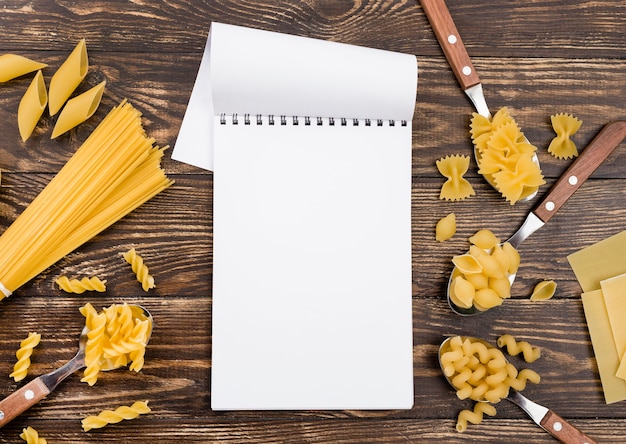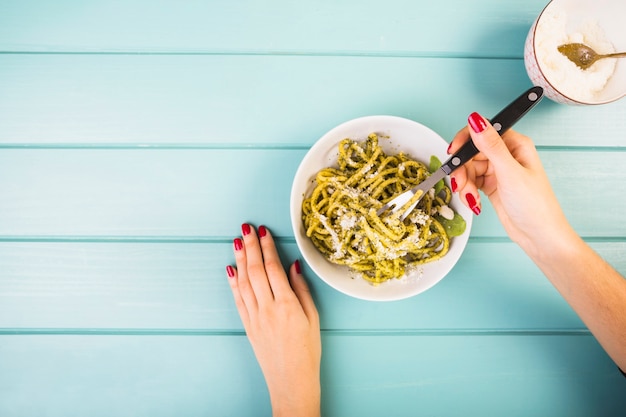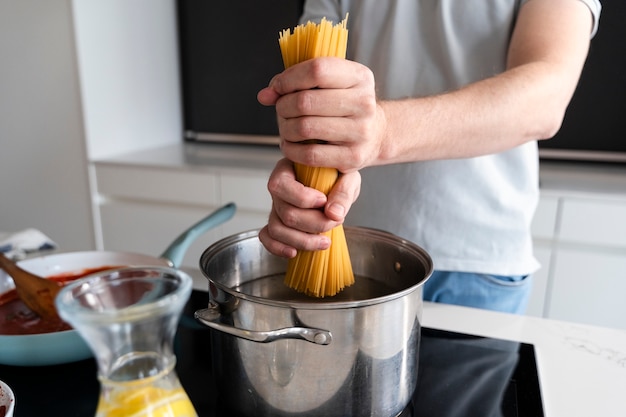(Part 1) Choosing Your Weapons

The Pasta: The Foundation of Your Dish
First things first, the pasta. It's the foundation of your dish, so don't skimp. I'm a big fan of de Cecco – it's reliable, good quality, and widely available. But hey, don't be afraid to experiment! There are so many amazing artisan pasta brands out there, each with its unique personality. Don't be afraid to try some different shapes. For a classic spaghetti, stick to spaghetti. You know, the long, thin strands that are perfect for twirling on a fork. But if you fancy something different, spaghetti alla chitarra, a square-cut spaghetti, is a great alternative. It offers a more rustic texture and holds its shape better in sauces.
Now, a word on the quantity. We all know that dreaded moment when you’re left with a mountain of pasta and a measly tablespoon of sauce. A good rule of thumb is to use about 100 grams of dry pasta per person. But hey, if you’re feeling extra hungry, go for it!
The Sauce: The Heart of Your Spaghetti
Right, onto the sauce. Now, this is where the fun truly begins! We're not talking about those jarred concoctions. We're talking about fresh, homemade goodness. Personally, I'm a big fan of a simple tomato sauce with garlic and basil. It's classic, it's flavourful, and it's incredibly versatile. But the beauty of spaghetti is that you can really let your culinary imagination run wild.
Want something a bit richer? A creamy carbonara with pancetta and Parmesan is a real treat. Feeling adventurous? Try a spicy arrabbiata or a tangy pesto sauce. The world is your oyster, my friend.
No matter which sauce you choose, remember this: a good sauce is the key to amazing spaghetti. It's what brings all the flavours together and makes the dish truly special. Don't be afraid to experiment and find a sauce that you love!
(Part 2) Mastering the Art of Boiling

Okay, so you’ve got your pasta and your sauce. Now it's time to get down to the nitty-gritty of cooking. This might seem straightforward, but believe me, there’s a right way and a wrong way to do it.
The Pot and the Water: The Right Tools for the Job
First things first, you need a large pot. The bigger the better, trust me. You need plenty of space for your pasta to swim freely. Fill the pot with water and bring it to a rolling boil. Remember, it needs to be bubbling furiously!
Salt, Salt, Salt: The Secret Ingredient
Right, now for the crucial ingredient: salt. And I don't mean a pinch. You need to generously salt the water. Think of it like seasoning the pasta itself. It infuses it with flavour and helps the pasta cook evenly.
Don't be shy with the salt! A generous amount of salt will enhance the flavour of the pasta and create a more vibrant dish overall. You can always add more salt later if you find it's not salty enough.
Adding the Pasta: The Moment of Truth
Now, add your pasta to the boiling water. Don’t crowd the pot – give it some space to move around. Start a timer, but don’t just mindlessly stare at it. Now is the time to taste.
Keep an eye on your pasta as it cooks. You want to make sure it's not sticking together or becoming mushy. If you notice any sticking, gently stir the pasta to loosen it up.
(Part 3) The Al Dente Enigma: Achieving Perfect Texture

Listen, I know it's a bit of a cliché, but "al dente" is the key to perfect spaghetti. It means “to the tooth,” and that's precisely what you want. It should have a slight resistance when you bite into it, not be mushy and overcooked. It's a delicate balance, but don't panic!
Tasting the Pasta: The Ultimate Test
To test if it’s al dente, simply remove a strand of pasta and bite into it. It should have a slight resistance, but not be hard. If you find it’s still a bit too firm, pop it back in the water for another minute or two.
Remember, the cooking time will vary depending on the type of pasta. A good rule of thumb is to start with the time on the packet, but always check by tasting. It’s better to err on the side of slightly undercooked than overcooked.
Overcooked pasta will be mushy and will not hold its shape well in the sauce. Undercooked pasta, on the other hand, will be too firm and will not absorb the sauce properly.
(Part 4) Draining the Pasta: The Next Step
Once your pasta is al dente, it's time to drain it.
The Colander: Your Drain-Saving Hero
Grab your colander and place it over the sink. Now, carefully pour the pasta into the colander, making sure to reserve a cup or two of the pasta water.
Don't Rinse!: The Secret to Creamy Sauce
This is where a lot of people go wrong. Don't rinse the pasta! That pasta water is packed with starch, which is crucial for a creamy sauce.
Rinsing the pasta will remove the starch, which will result in a thinner, less flavorful sauce.
(Part 5) The Sauce: The Final Touch
Your pasta is al dente, drained, and ready to go. Now it’s time to add the sauce.
The Perfect Blend: Bringing It All Together
Heat your sauce in a large pan. Once it’s bubbling, add the pasta and toss it gently to coat it evenly. This is where that reserved pasta water comes in handy. Add a splash or two to the pan to loosen up the sauce and create a silky smooth consistency.
The reserved pasta water is a little bit of magic that can help you create a perfect sauce. It adds a bit of starch and flavor to the sauce, creating a richer and more flavorful final dish.
Garnish It!: Adding the Finishing Touches
Now, it's time to get creative. Add some fresh herbs, a sprinkle of parmesan, or a drizzle of olive oil.
Fresh herbs can really elevate the flavor of your spaghetti. A sprinkle of basil, parsley, or oregano can add a fresh, bright flavor to your dish. Parmesan cheese adds a salty, nutty flavor and a rich texture to the spaghetti. And a drizzle of olive oil adds a bit of richness and shine to the finished dish.
(Part 6) Plating the Dish: Presentation Matters
Right, your spaghetti is ready to be plated! Get a large, shallow bowl and carefully transfer the pasta to the plate.
Presentation Matters: A Feast for the Eyes
Let's face it, we eat with our eyes first. So, take a moment to arrange the pasta beautifully on the plate. A touch of fresh basil, a sprinkle of parmesan, and a drizzle of olive oil can make all the difference.
The way you plate your spaghetti can really impact the overall dining experience. A beautifully presented dish is more inviting and appealing, and it will make your meal more enjoyable.
(Part 7) Serving Suggestions: Beyond the Basics
Spaghetti is a fantastic dish that can be enjoyed on its own, but it’s also a versatile base for endless culinary creations.
Classic Combinations: Tried and True Favourites
Here are a few of my favourite serving suggestions:
- Spaghetti alla Carbonara: This classic Italian dish features a creamy sauce made with eggs, pancetta, and Parmesan cheese. It's simple yet incredibly delicious.
- spaghetti aglio e olio: A simple but oh-so-delicious dish made with garlic, olive oil, and red pepper flakes. It's a perfect way to showcase the flavour of the pasta itself.
- spaghetti with pesto: A fresh and vibrant dish made with a basil pesto sauce.
- Spaghetti with Meatballs: A classic comfort food dish that's always a hit.
- Spaghetti with Sausage: Another hearty and flavourful dish that's perfect for a cold night.
But hey, don't be afraid to get creative!
Experimenting with Flavors: Discover New Delights
One of the best things about spaghetti is that you can customize it to your liking. Try adding different vegetables, meats, or cheeses to your sauce. You can also experiment with different herbs and spices to create unique flavour combinations.
For a vegetarian option, try adding mushrooms, spinach, or zucchini to your sauce. For a meaty dish, try adding ground beef, sausage, or chicken. And for a cheesy delight, try adding ricotta cheese, mozzarella cheese, or Parmesan cheese. The possibilities are endless!
(Part 8) The Art of Enjoyment: Savor the Moment
Right, your spaghetti is ready. Now, sit back, relax, and enjoy the fruits of your labour.
Savor the Moment: Appreciate the Flavors
Take a moment to appreciate the aroma, the texture, and the flavours of your creation.
Don't rush through your meal. Take your time and enjoy each bite. Notice the different flavors and textures of the dish.
Share the Love: Enjoy with Loved Ones
Spaghetti is a dish best enjoyed with friends and family. So, gather around and share this culinary masterpiece.
Spaghetti is a great dish to share with loved ones. It's a comforting and satisfying meal that can bring people together. So, invite your friends and family over for a delicious spaghetti dinner.
(Part 9) FAQs: Solving Your Spaghetti Dilemmas
Now, I know you might have some questions, so here are some of the most common ones:
| Question | Answer |
|---|---|
| What’s the best way to cook spaghetti? | Follow the steps outlined in this guide, and you’ll be well on your way to cooking perfect spaghetti. Remember, the key is to cook the pasta al dente and use a delicious homemade sauce. |
| Can I use store-bought sauce? | Sure, if you're in a pinch, you can use store-bought sauce. But if you have the time, I highly recommend making your own. It's really not that difficult, and the flavour is unbeatable. |
| How long should I cook spaghetti? | Cooking time will vary depending on the type of pasta. A good rule of thumb is to start with the time on the packet, but always check by tasting. It’s better to err on the side of slightly undercooked than overcooked. |
| What should I serve with spaghetti? | Spaghetti is a versatile dish that can be enjoyed on its own, but it's also a fantastic base for endless culinary creations. From classic combinations like spaghetti alla carbonara to more adventurous creations, the possibilities are endless. |
| Can I reheat spaghetti? | Yes, you can reheat spaghetti. However, it's best to reheat it in a pan with a little bit of sauce to prevent it from drying out. |
And there you have it. Now go forth and conquer the world of spaghetti. You've got this!
Everyone is watching

Corn on the Cob: The Ultimate Guide to Perfectly Cooked Ears
Healthy MealsAh, corn on the cob. Just the name evokes images of sunny days, barbecues, and that sweet, juicy flavour that ...

Perfect Pork Roast Oven Cooking Time: A Guide to Delicious Results
Healthy MealsThere's something truly satisfying about a perfectly roasted pork. The aroma alone is enough to make your mout...

Ham Cooking Time: How Long to Bake, Smoke, or Boil a Delicious Ham
Healthy MealsAh, ham. It's a classic, isn't it? A real crowd-pleaser, especially around holidays. And when done right, it'...

Scallops: The Ultimate Guide to Perfect Cooking
Healthy MealsAh, scallops. Those delicate, sweet, and utterly delicious morsels of the sea. They hold a special place in my...

Spaghetti Squash: The Ultimate Guide to Cooking and Serving
Healthy MealsRemember that time you saw spaghetti squash at the supermarket, looking all bumpy and strange, and thought, "W...
